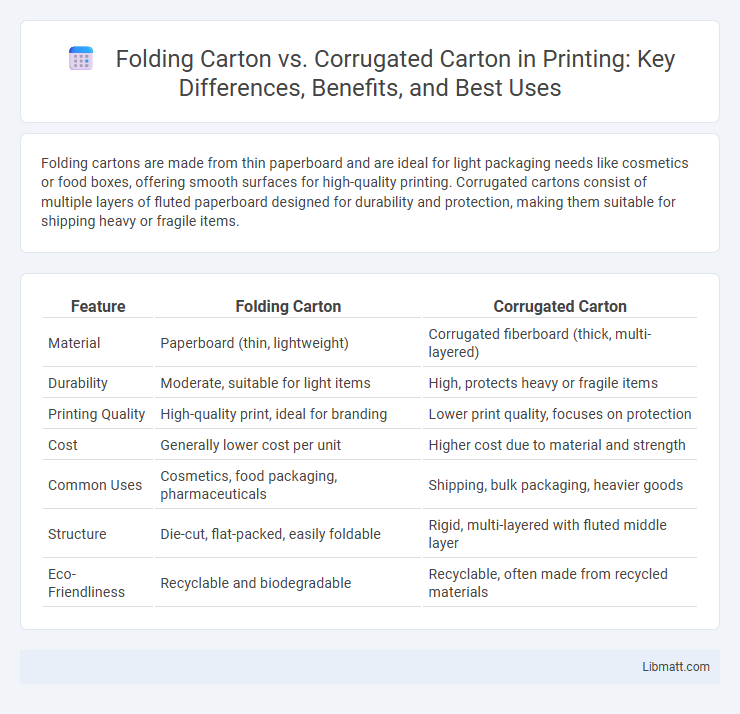Folding cartons are made from thin paperboard and are ideal for light packaging needs like cosmetics or food boxes, offering smooth surfaces for high-quality printing. Corrugated cartons consist of multiple layers of fluted paperboard designed for durability and protection, making them suitable for shipping heavy or fragile items.
Table of Comparison
| Feature | Folding Carton | Corrugated Carton |
|---|---|---|
| Material | Paperboard (thin, lightweight) | Corrugated fiberboard (thick, multi-layered) |
| Durability | Moderate, suitable for light items | High, protects heavy or fragile items |
| Printing Quality | High-quality print, ideal for branding | Lower print quality, focuses on protection |
| Cost | Generally lower cost per unit | Higher cost due to material and strength |
| Common Uses | Cosmetics, food packaging, pharmaceuticals | Shipping, bulk packaging, heavier goods |
| Structure | Die-cut, flat-packed, easily foldable | Rigid, multi-layered with fluted middle layer |
| Eco-Friendliness | Recyclable and biodegradable | Recyclable, often made from recycled materials |
Introduction to Folding Carton and Corrugated Carton
Folding cartons are lightweight packaging solutions made from paperboard, commonly used for retail products like cosmetics, pharmaceuticals, and food items due to their excellent printing surface and easy assembly. Corrugated cartons consist of a fluted corrugated sheet sandwiched between linerboards, offering superior strength and cushioning ideal for shipping and protecting heavy or fragile goods. Understanding the differences between your folding carton and corrugated carton options helps optimize packaging efficiency based on product protection and presentation requirements.
Key Differences Between Folding and Corrugated Cartons
Folding cartons are made from thin, paperboard sheets ideal for lightweight products and retail packaging, offering excellent print quality and ease of folding for compact storage. Corrugated cartons consist of thick, durable cardboard with multiple fluted layers, designed to protect heavy or fragile items during shipping and handling. Your choice depends on the required strength and presentation, with folding cartons suited for display and corrugated cartons preferred for structural protection.
Material Composition and Structure
Folding cartons are typically made from paperboard, a thin, lightweight material composed of multiple layers of paper pulp, providing smooth surfaces ideal for high-quality printing and precise folding. Corrugated cartons consist of a fluted corrugated sheet sandwiched between two linerboards, offering enhanced strength and durability to protect heavy or fragile items during shipping. The distinct structural differences result in folding cartons being favored for retail packaging while corrugated cartons are preferred for transportation and storage.
Design and Printing Capabilities
Folding cartons offer superior design and printing capabilities with smooth surfaces ideal for high-resolution graphics, vibrant colors, and detailed branding elements. Corrugated cartons, made from fluted cardboard, provide durability but have a rougher texture that limits intricate printing and design options. Your choice depends on the need for eye-catching packaging versus robust protection during shipping.
Strength and Durability Comparison
Folding cartons, made from paperboard, offer moderate strength suitable for lightweight products but lack the durability to withstand heavy loads or rough handling. Corrugated cartons consist of multiple layers, including a fluted corrugated sheet, providing superior strength and resistance to crushing, making them ideal for shipping and protecting heavy or fragile items. Their enhanced durability and cushioning properties ensure better protection during transportation compared to folding cartons.
Applications and Industry Uses
Folding cartons are widely used in retail packaging for consumer goods such as cosmetics, pharmaceuticals, and food products due to their printability and lightweight design. Corrugated cartons are preferred in industrial and shipping applications where durability and protection for heavy or fragile items are crucial, commonly serving electronics, automotive parts, and e-commerce sectors. Your choice between folding and corrugated cartons depends on the specific requirements of protection, presentation, and handling within your industry.
Cost Considerations and Budget Impact
Folding cartons typically offer lower initial costs and are ideal for lightweight packaging needs, making them budget-friendly for small to medium-sized products. Corrugated cartons provide superior durability and protection but come at a higher price, impacting your overall packaging budget, especially for heavy or fragile items. Evaluating the balance between cost efficiency and product safety is crucial to optimizing your packaging expenditure.
Environmental Impact and Sustainability
Folding cartons are typically made from paperboard, which is easier to recycle and often sourced from renewable materials, contributing to a lower environmental impact compared to corrugated cartons. Corrugated cartons, made from multiple layers of kraft paper, offer greater durability and protection but can be heavier and consume more resources during production. Your choice between folding and corrugated cartons can influence sustainability outcomes depending on recyclability, resource use, and the specific needs of your packaging application.
Choosing the Right Carton for Your Product
Selecting the right carton depends on product weight, protection needs, and presentation goals. Folding cartons offer sleek, lightweight packaging ideal for retail display and light to moderate protection, while corrugated cartons provide sturdy, durable support for heavy or fragile items during shipping. Understanding these material differences ensures optimal product safety and enhances customer experience through packaging choice.
Final Thoughts: Which Carton is Best for You?
Folding cartons offer excellent graphic appeal and are ideal for lightweight packaging requiring precise printing and branding, while corrugated cartons provide superior strength and cushioning for heavy or fragile items during shipping. Choosing between folding and corrugated cartons depends on your specific needs such as durability, product protection, and visual impact. Evaluate factors like product weight, shipping conditions, and marketing priorities to determine the most effective carton type for your business.
Folding Carton vs Corrugated Carton Infographic

 libmatt.com
libmatt.com